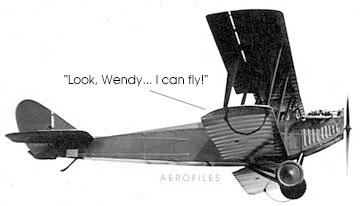|
(excerpted from a 1921 aviation magazine)  1. Never attempt to fly a Jenny with its motor missing. It is always better in the long run to delay a flight until the motor can be found and placed back in the ship where it belongs. 2. All Jennys should be equipped with booster magnetos, as the plane can often be boosted over low fences, small dogs, and neighboring flower beds with this equipment. 3. The simplest, safest way to get a Jenny out of a small field is with a good dray and a team of mules. 4. When dirt collects in the wheel spokes, an easy method of removal is to land cross-wind in a stout gale. This should wipe the wheels free of dirt. In fact, this usually wipes out the entire landing gear. 5. The best way to elevate a Jenny several hundred feet is by using the elevator. When the elevator stops, the machine should be held in this position by the prop. As soon as the engine is sufficiently warm, the prop can be knocked away, and the ensuing dive will result in enough speed to clear low fences, small dogs, and neighboring flower beds, barring any adverse winds. 6. If you are forced to land in a dense forest, a knowledge of pancake landings is handy. Although some think the extra weight of carrying enough pancakes for an emergency landing would decrease the performance prohibitively, I have found in my more than four hours in the air that the feeling of safety in knowing you are prepared more than offsets that loss of performance. 7. I should mention here than when flying in Iowa during the harvest season, it is wise to double up on your shock absorbers, as in landing on an oat field, where the shocks are most profuse, I found that single units do not fare well in coping with these. I was once unable to absorb the oat shocks as I ran into them on landing with the final result that when I hit the twelfth one, my propeller caught a quantity of oats and blew them into the radiator, where heat and moisture caused them to swell profusely into an oatmeal-like consistency, completely filling the air passages and making it necessary for me to discard the engine and install an air-cooled one. 8. A "Three-Point Landing" specifically refers to two wheels and a tailskid and not, as many seem to assume, two wing tips and a propeller. 9. A good, reliable compass should be in every ship, for in any cross-country flying, especially passing through clouds or fog, it is very easy to lose one's bearings. This was forcibly brought to my notice during my recent flight to China, which I foolishly attempted without a compass. When well out over the Pacific, I encountered fog and, within the space of a few minutes, had completely lost my bearings. Not only my main bearings, but my crankshaft, as well. I did not notice this at the time and kept going until I arrived in China a few days later. You can imagine, after I stopped to take on gas, my dismay when I tried cranking the motor and found the crankshaft was missing. Well, an engine is no good without a crankshaft, so, in order to get on with my trip, I had to have the ship towed by some local oxen to the top of a hill. As I gained speed in the descent, I engaged the landing gear with the timing gear, and the ship took off in a spectacular manner. In fact, it took off two chimneys, plus a Chinaman's queue, which I could not dodge as it was standing straight up, no doubt from fright. Ever since I have made a point of using a compass.  |